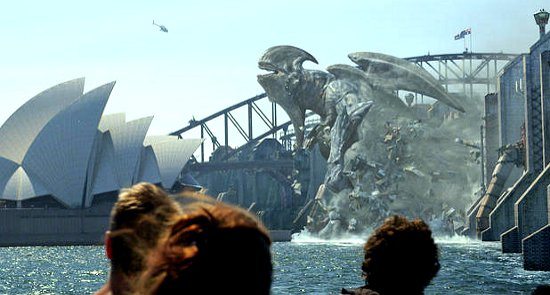

It’s no secret that action and explosions sell movie tickets, but on the one hand there is a significant difference between heroically crashing $250,000 Nissan Skylines in drag races and police chases, fictional shootouts inside the Matrix, and secret agents destroying evidence with exploding pens, and on the other hand, the complete and utter destruction of midtown Manhattan and all its residents. It does not seem that filmmakers, or audiences, are really considering this difference seriously.
The Eiffel Tower, the White House, Grand Central Station, the Statue of Liberty, Times Square, the Golden Gate Bridge, the Brooklyn Bridge…no matter how many times they have been destroyed in previous films, we never seem to tire of seeing them get blown up again. Filmmakers continue to destroy and audiences continue to watch, not just landmarks but entire cities. Why do we desire this kind of massive destruction of our cities in film?
The utter destruction of a city, or cities, is usually caused by one of more of the following:
1. A battle to save humanity, either from a monster, or from aliens.
2. Natural disasters like tidal waves, solar flares, or disease.
3. Human malevolence, AKA terrorism.
Executing natural disaster scenarios on screen may be necessary if the disaster is a massive part of the plot, as in "Deep Impact". In tidal wave scenes, the wave coming ashore is not just visually stunning, but it is also climactic in the story arc. Gratuitous and extreme is the wave’s total destruction of lower Manhattan.
In terrorist scenarios, setting the destruction sequences in cities is essential to creating realistic situations, since terrorists target large populated areas. But is it really it necessary to show the result of a successful terrorism plot in action? Rarely do we see terrorists take down an entire city, so small scale violence caused by terrorists, like say "Die Hard", is used to sustain the forward momentum of action-thrillers
So both terrorist attacks and natural disaster destruction sequences can commonly be justified by the purposes they serve in the film’s storyline. Newish films like "Pacific Rim","The Avengers", and most recently "Godzilla" all involve the major destruction of cities using monsters or aliens, but destruction of this type is not as easily justified. If an alien battle was truly just about saving the Earth, these battles need not necessarily take place in cities, yet they always conveniently do. The battles rarely take place where there is nothing to destroy spectacularly on screen, like the desert, or in open ocean. "Pacific Rim" and "Godzilla" have creatures spawned from the ocean that still end up on land, wreaking havoc and destroying Hong Kong and San Francisco.

In his book "Cities, War, and Terrorism", focused on the destruction of cities, editor Steven Graham proclaims that his research has shown that humankind has spent just as much energy destroying cities as erecting them. Not only that, annihilating a city takes just as much sophisticated planning and effort as sustaining and running a non-annihilated city. Graham’s descriptions make it sound as if there is a business of annihilating cities, an actual industry, employing huge workforces and creating major economic influence. Maybe this industry of annihilation is using film to subliminally to implant us with their mentality: KILL, DESTROY, BUY HALIBURTON ENRICHED URANIUM.
The film journal East-West dedicated an issue in 1988 to cities in film, where they list some truism about cities and film that still apply today. Since cities are the producers of much of modern culture’s artifacts, and the most direct representation of humankind upon the modern landscape, destroying cities symbolizes so many things. By destroying the city, we are destroying the pinnacle of human achievement. Films of type two or type three infer an imbalance, a glitch in the culture and the people that build it. If the entire cityscape of mankind were destroyed by a wave or a bomb, a hopeful outlook would suggest potential new beginnings that could follow. A chance to start over, to right the wrongs that ultimately brought about the destruction. To not kill the planet, to not fight wars amongst ourselves. If we survive the destruction we get a chance to rebuild new cultural institutions, and hopefully we won’t blow ourselves up the second time around.
As for the aliens and monsters, hopefully we meet some friendly ones soon that can communicate that they would never blow up our cities so we can stop speculating. Then we can get back to drag racing turbo-charged imports, ramping buses off freeways, and blowing up all the stuff that really matters.